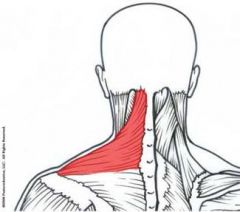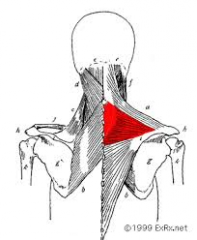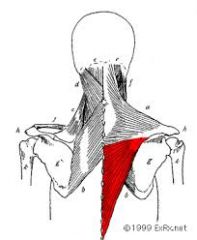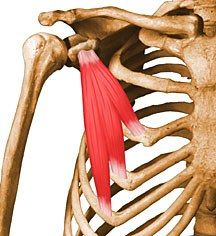![]()
![]()
![]()
Use LEFT and RIGHT arrow keys to navigate between flashcards;
Use UP and DOWN arrow keys to flip the card;
H to show hint;
A reads text to speech;
60 Cards in this Set
- Front
- Back
|
bones
|
scapula clavicle sternum humerus rib cage |
|
|
joints
|
sternoclavicular acromioclavicular glenohumeral scapulothoracic functional articulation |
|
|
shoulder girdle
|
scapula and clavicle
|
|
|
shoulder joint
|
between glenoid fossa of scapula and head of humerus
|
|
|
only direct attachment of upper extremity to the trunk
|
sternoclavicular
|
|
|
sternoclavicular accompany shoulder girdle motions
|
elevation/depression protraction/retraction rotation |
|
|
sternoclavicular ligament
|
sternum to clavicle anterior limits posterior movement of clavicle posterior limits anterior movement of clavicle reinforces joint capsule |
|
|
costoclavicular ligament
|
limits clavicular elevlation 1st rib to clavicle |
|
|
interclavicular ligament
|
connects sternal ends of clavicles limits clavicular depression |
|
|
acromioclavicular jint
|
connects acromion process with lateral clavicle elevation/depression of scapula with clavicle protraction/retraction of scapula with clavicle rotation of scapula with clavicle |
|
|
holds the acromion process to the clavicle and prevents dislocation of the clavicle
|
acromioclavicular joint
|
|
|
coracoclavicular ligament
|
helps reinforce the joint by holding the bones together
|
|
|
acromioclavicular ligament
|
reinforce the joint capsule
|
|
|
coracoacromial ligament
|
roof over head of the humerus, serves as a protective arch
|
|
|
scapulothoracic articulation
|
not a true joint scapula connected indirectly via the clavicle and several muscles provides motion and flexiblity |
|
|
scapulohumeral rhythm
|
the term used to describe the movement relationship between the shoulder girdle and shoulder joint 2 degree of shoulder abduction, the scapula upwardly rotates one degree |
|
|
angle of pull
|
muscles only pull in one direction
|
|
|
vertical pull
|
elevating or depressing the scapula
|
|
|
horizontal pull
|
retract or protract the scapula
|
|
|
diagonal pull
|
cause motion in both planes
|
|
|
5 primary muscles, all originate on trunk
|
trapezius levator scapulae rhomboids serratus anterior pectoralis minor |
|
|
upper trapezius Origin
|

Occipital protuberance and nuchal ligament
|
|
|
upper trapezius insertion
|
lateral clavicle and acromion process
|
|
|
upper trapezius action
|
scapular elevation upward rotation of scapula |
|
|
upper trapezius nerve |
CN XI 11 |
|
|
middle trapezius
|

|
|
|
middle trapezius origin
|
spinous processes C7-T3
|
|
|
middle trapezius insertion
|
spine of the scapula
|
|
|
middle trapezius action
|
scapular retraction
|
|
|
middle trapezius nerve
|
CN XI
|
|
|
lower trapezius
|

|
|
|
lower trapezius origin
|
spinous processes of T4-T12
|
|
|
lower trapezius insertion
|
root of spine of scapula
|
|
|
lower trapezius action
|
scapular depression upward rotation of scapula |
|
|
lower trapezius nerve
|
CN XI
|
|
|
levator scapula
|

|
|
|
levator scapula origin
|
C1-C4 transverse processes
|
|
|
levator scapula insertion
|
vertebral border of scapula from the superior angle to root of spine
|
|
|
levator scapula action
|
elevation downward rotation of scapula |
|
|
levator scapula nerve
|
dorsal scapular nerve
|
|
|
rhomboid major and minor
|

|
|
|
rhomboid origin
|
spinous processes C7-T5
|
|
|
rhomboid insertion
|
vertebral border of scapula from root of spine to inferior angle
|
|
|
rhomboid action
|
scapular retraction downward rotation |
|
|
rhomboid nerve
|
dorsal scapular nerve
|
|
|
pectoralis minor
|

|
|
|
pectoralis minor origin
|
anterior surface ribs 3-5
|
|
|
pectoralis minor insertion
|
coracoid process of scapula
|
|
|
pectoralis minor action
|
depression protraction downward rotation of the scapula |
|
|
pectoralis minor nerve
|
medial pectoral nerve
|
|
|
force couple
|
muscles pulling in different directions to produce rotation
|
|
|
force couple for upward rotation
|
upper trapezius - pulls up lower trapezius - pulls down serratus anterior - pulls out horizontally |
|
|
force couple for downward rotation
|
levator scapulae - pulls up rhomboids - pull in pectoralis minor - pulls down |
|
|
muscle concentric contraction results in origin moving towards insertion, usually results when origin is fixed
|
reversal of action
|
|
|
elevators of the scapula
|
upper trapezius levator scapula |
|
|
depressors of the scapula
|
pectoralis minor lower trapezius |
|
|
protractors of the scapula
|
pectoralis minor serratus anterior |
|
|
retractors of the scapula
|
middle trapezius rhomboids |
|
|
upward rotators of the scapula
|
upper trapezius lower trapezius serratus anterior |
|
|
downward rotators of the scapula
|
levator scapula rhomboids pectoralis minor |

